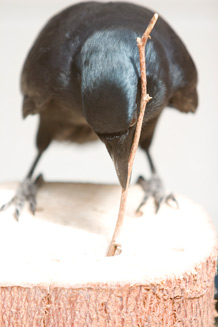
A captive New Caledonian crow uses a stick tool. Photo by Dr Simon Walker.
CSI-style detection work reveals the advantage for crafty crows
Scientists from the University of Exeter have used ‘CSI-style’ detective work to help reveal the huge evolutionary advantage that can be gained by animals using tools to forage for food.
Dr Stuart Bearhop, from the University’s School of Biosciences (Cornwall Campus) and Dr Christian Rutz, from the University of Oxford, worked with their research teams to study New Caledonian crows.
The birds are one of the few species in the animal world to have developed the ability to use tools – using sticks to extract beetle larvae from the inside of trees.
The work was based on an MSc project originally carried out by Nicola Reed at the Cornwall Campus, and findings from the research showed that larvae were so energy rich and full of fat that just a few specimens can satisfy a crow’s daily energy requirements.
Dr Bearhop said: "Using tools is seen as a really key moment in human evolution, but it's very rare in the animal world. There's been lots of speculation about the advantages tool use can bring, but there's been no clarification on the ecological role it plays.”
Dr Rutz added: “With their tool use, these crows are getting access to a very calorie-rich, fatty food source, and it seems very likely that natural selection would strongly favour such an advantage.
“Other factors have probably played a role, too, but at least we now have a much better understanding of the dietary significance of this remarkable behaviour.”
To get the findings, the researchers had to find out just how important the larvae were in the crows’ diet but observing the birds in the wild, on their home island in the South Pacific, is extremely difficult because they are easily disturbed and live in densely forested mountainous terrain.
To get round this, the scientists came up with an unconventional approach. The larvae the birds collect by using tools have a distinct chemical fingerprint — their stable isotope profile — that can be traced in the crows’ feathers and blood, enabling efficient sample collection with little or no harm to the birds.
Dr Rutz, said: “By comparing the stable isotope profiles of the crows’ tissues with those of their putative food sources, we could estimate the proportion of larvae in crow diet, providing a powerful proxy for individual tool-use dependence.”
Dr Bearhop added: “The approach we used is very similar to that employed by forensic scientists trying to solve crimes, and has even appeared on CSI.
“We have helped develop very powerful statistical models that enabled us to use the unique fingerprints, or stable isotope profiles, of each food type to estimate the amount of beetle larvae consumed by individual New Caledonian crows.”
The scientists believe that their novel approach could prove key to investigating in the future whether particularly proficient tool users, with their privileged access to larvae, produce offspring of superior body condition, and whether a larva-rich diet has lasting effects on future survival and reproduction.
Dr Rutz added: “The fact that we can estimate the importance of tool use from a small tissue sample opens up exciting possibilities. This approach may even be suitable for studying other animal tool users, like chimpanzees.”
Tool use is so rare in the animal kingdom that it was once believed to be a uniquely human trait. While it is now known that some non-human animal species can use tools for foraging, the rarity of this behaviour remains a puzzle.
It is generally assumed that tool use played a key role in human evolution, so understanding this behaviour’s ecological context, and its evolutionary roots, is of major scientific interest.
A report of the research appears in this week’s Science.
Date: 17 September 2010
